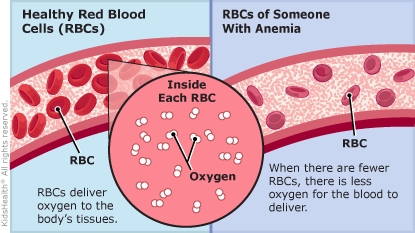- Home
- Humana Medicaid
- Kentucky Medicaid
- Medicaid extras
- Health and wellness
- Parents Home
- Para Padres
- A to Z Dictionary
- Allergy Center
- Asthma
- Cancer
- Diabetes
- Diseases & Conditions
- Doctors & Hospitals
- Emotions & Behavior
- First Aid & Safety
- Flu (Influenza)
- Food Allergies
- General Health
- Growth & Development
- Heart Health & Conditions
- Homework Help Center
- Infections
- Newborn Care
- Nutrition & Fitness
- Play & Learn
- Pregnancy Center
- Preventing Premature Birth
- Q&A
- School & Family Life
- Sports Medicine
- Teens Home
- Para Adolescentes
- Asthma
- Be Your Best Self
- Body & Skin Care
- Cancer
- Diabetes
- Diseases & Conditions
- Drugs & Alcohol
- Flu (Influenza)
- Homework Help
- Infections
- Managing Your Weight
- Medical Care 101
- Mental Health
- Nutrition & Fitness
- Q&A
- Safety & First Aid
- School, Jobs, & Friends
- Sexual Health
- Sports Medicine
- Stress & Coping
Anemia
What Is Anemia?
Anemia is when the number of red blood cells in the body gets too low. Red blood cells carry hemoglobin (HEE-muh-glow-bin), a protein that carries oxygen throughout the body. Without enough of them, oxygen doesn't get to the body's organs. Without enough oxygen, the organs can't work normally.
There are many different kinds of anemia, so treatments vary.

What Are the Different Kinds of Anemia?
The types of anemia are based on what causes them. They include:
- Anemias from when red blood cells get broken down too fast, called hemolytic anemias. They include:
- autoimmune hemolytic anemia: when the body's immune system destroys its own red blood cells
- inherited hemolytic anemias: these include sickle cell disease, thalassemia, G6PD deficiency, and hereditary spherocytosis
- Anemia from bleeding. This can happen due to bleeding from an injury, heavy menstrual periods, the gastrointestinal tract, or another medical problem.
- Anemia from red blood cells being made too slowly, such as:
- aplastic anemia: when the body stops making red blood cells from an infection, illness, or other cause
- iron-deficiency anemia: when someone doesn't have enough iron in their diet
- deficiencies in vitamins including B12 or folate: when someone doesn't get enough B12 or folic acid in the diet or the body can't absorb them properly
- problems with the bone marrow that prevent it from making red blood cells normally, such as leukemia
What Are the Signs & Symptoms of Anemia?
If the anemia is mild or develops slowly over time, some children don't have any symptoms. A child who does have symptoms might:
- look pale
- seem moody
- be very tired
- feel dizzy or lightheaded
- have a fast heartbeat
- have jaundice (yellow skin and eyes), an enlarged spleen, and dark tea-colored pee (in hemolytic anemias)
Young children with iron-deficiency anemia also might have developmental delays and behavioral problems.
How Is Anemia Diagnosed?
Doctors usually can diagnose anemia by:
- asking questions about symptoms
- asking about diet
- asking if any family members have anemia
- doing a physical exam
- doing blood tests to:
- look at the red blood cells with a microscope to check their size and shape
- check the amount of hemoglobin and iron in the blood
- check how fast new RBCs are being made
- test for any inherited anemias
- check other cells made in the bone marrow (such as white blood cells)
Sometimes doctors do tests on the bone marrow. The bone marrow is the spongy part inside the bone where blood cells are made. For this test, the doctor puts a needle into the bone to take a small bone marrow sample. The sample is sent to the lab for special tests.
How Is Anemia Treated?
Treatment for anemia depends on the cause. Kids and teens with anemia might need:
- medicines
- changes in their diet
- blood transfusions
- treatment of another underlying disease
- to see a hematologist (a doctor who treats anemia and other blood problems)
How Can Parents Help?
Most kinds of anemia are treatable. It may take a while for symptoms to go away, so your child should take it easy while recovering.
To help your child get the best care:
- Go to all doctor's visits.
- Follow the doctor's recommendations.

© 1995- The Nemours Foundation. KidsHealth® is a registered trademark of The Nemours Foundation. All rights reserved.
Images sourced by The Nemours Foundation and Getty Images.